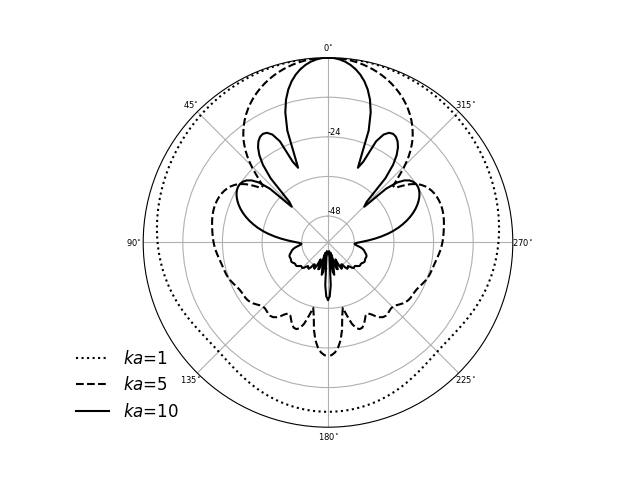Note
Click here to download the full example code
FLINT piston in sphere
This example shows how to run the FLINT piston in sphere implementation.
The python-flint package is the python port for the FLINT package in C,
and runs extremely fast in comparison to mpmath. However, it does
have its own conventions. This run-through will highlight the slight differences
that arise as a result.
Installation
The python-flint package currently works on both Windows and Linux! See here and here for step-by-step instructions.
Why use the python-flint implementation
The piston_in_sphere_flint directivity implementation is about an order of magnitude faster than the default mpmath piston_in_sphere_directivity implementation. The installation adds a one-time overhead of maybe upto to 1/2 - 1 hour. However, this investment pays off very fast. For example, imagine one parameter set takes 2 minutes with the default mpmath implementation, and you need to calculate 10,000 or so similar paramter sets. This implies 20,000 minutes (14 days) of computing time. However, with the python-flint implementation, the 2 minutes for one run already drops to ~0.2 minutes, and the total goes 2,000 minutes (~1.4 days) instead.
# sphinx_gallery_thumbnail_path = '_static//flint_pistoninsphere.png'
import matplotlib.pyplot as plt
import numpy as np
from beamshapes import piston_in_sphere_flint as piston_sphere # to speed things up!!
pistonsphere_directivity = piston_sphere.piston_in_sphere_directivity
from flint import acb # import the python-flint package
ka_values = [1, 5, 10]
a = 0.01 # piston of 1cm radius
angles = np.linspace(0,-np.pi,100) # angles from 0-180 degrees
The flint implementation of piston in a sphere only accepts an `acb`
complex number (see here),
and not an inbuilt float or np.float object. Also note how even functions
like sin and \(\pi\) are called from the `acb` module (`acb.pi`, `acb.sin`).
angles_as_acb = [acb(each) for each in angles]
R = acb(0.1) # radius of a sphere
alpha = acb.pi()/acb(6)
a_value = R*acb.sin(alpha)
piston_in_sphere_D = np.zeros((angles.size, len(ka_values)))
for j,each_ka in enumerate(ka_values):
k_value = acb(each_ka)/a_value
parameters = {'k':k_value, 'a':a_value, 'R': R, 'alpha':alpha}
A_n, piston_in_sphere_D[:,j] = pistonsphere_directivity(angles_as_acb, parameters)
line_types = ['dotted', 'dashed', 'solid']
plt.figure()
a1 = plt.subplot(111, projection='polar')
for j,ka in enumerate(ka_values):
plt.plot(angles, piston_in_sphere_D[:,j], color='k', linestyle=line_types[j])
plt.plot(-angles, piston_in_sphere_D[:,j], color='k', label=f'$ka$={ka}', linestyle=line_types[j])
a1.set_theta_zero_location('N')
plt.yticks([-12,-24,-36,-48], fontsize=6)
a1.set_rlabel_position(0) # Move radial labels away from plotted line
tick_angles = [0,45,90,135, 180,225,270,315]
tick_labels = []
for each in tick_angles:
tick_labels.append(f'{each}'+'$^{\circ}$')
plt.yticks([-12,-24,-36, -48],['',-24,'', -48], fontsize=6)
plt.xticks(np.radians(tick_angles) ,tick_labels , fontsize=6)
a1.xaxis.set_tick_params(pad=-3.5)
plt.legend(loc=(-0.2, 0.0), frameon=False, fontsize=12)
# plt.savefig('../docs/source/_static/flint_capinsphere.png')

Total running time of the script: ( 0 minutes 0.000 seconds)